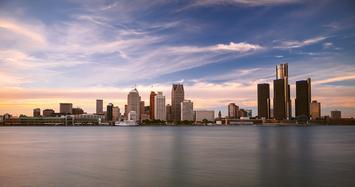
Detroit may have found something that could figure prominently in the city's long-term rebound.
Earlier this week I found this video, featuring the Detroit Academy of Arts and Sciences Choir and produced/sponsored by the Metro Detroit Convention and Visitors Bureau, and I was blown away by the quality and the message. In the week since its release the video has garnered nearly one million views. It's absolutely worth your five minutes to check it out:
And just yesterday I heard about the death of Detroit songwriter Allee Willis, who may be high on the list of famous people you absolutely never heard of. She was the writer of some very popular songs, perhaps most famously the theme song for the TV show Friends, but was also a big-time Detroit ex-pat representing the Motor City in Los Angeles. Sadly, I'd never heard of her until her death, but I'm glad I did hear of her and her work.
I found out in 2017 she produced her own video on Detroit, bringing together many musical friends in Detroit to celebrate the city. Again, another five minutes worth your time:
These two videos signal something very different about the messaging coming out of Detroit today. Rather than the standard "we have all the amenities you love!" that most cities try to promote, touting urban sameness rather than distinctiveness or authenticity, the message coming out of Detroit is, "we're still here! We made it and we're stronger for it!" This can also be seen in the video produced for Detroit's failed Amazon HQ2 bid, also from 2017:
And perhaps the most famous one of all, the "Imported From Detroit" Chrysler Super Bowl commercial from 2011, featuring Eminem:
Each of these is a contribution to a new narrative of Detroit that could resound for decades. Here's why.
Rebranding
As I noted above, so many cities produce videos showing how they have vibrant nightlife with hot restaurants, and show off their very limited walkable upscale areas as untrue examples of what the entire city is like. For Rust Belt cities this often comes across even worse, because there's an insecurity that inhabits the Rust Belt psyche as it struggles to reconcile what it once was with what it is today. Decades of job loss, population loss, neighborhood loss and building loss, all while watching cities elsewhere prosper, made Rust Belters anxious about their cities. Detroit, however, has turned that negative into a positive.
Resilience
Detroit is also sending out the message that its darkest days are behind it, it is full of proud people who have weathered to storm, and that it is welcoming strong people who are able to withstand the heat (forgive my metaphor mixing). This stands in contrast to other cities that want to appeal to the nation's best and brightest and compete for top talent. Detroit will definitely accept top talent -- but only if they are willing to roll up their sleeves and contribution to the city's...
Redemption
Readers here will note that I don't view Detroit's recent rebound as revitalization per se. I see what's happening in Detroit as redemption, simply reclaiming what's been lost over the decades. Or as I've said before:
"Detroit is coming back because it's reclaiming its position as the largest city in a large state, meaning economic and social assets that were once scattered about are once again consolidating there. But it's also coming back because the city's meta-narrative is slowly changing before our eyes."
And the process of redemption is indeed important for Detroit. Before actual revitalization, Detroiters need to feel good about themselves and the city again. Suburbanites must feel good about their relationship with the city. Michiganders must feel good about the vibrancy of the state's largest city. Detroit ex-pats must feel good about promoting the city to potential newcomers.
And newcomers will partner with the resilient people to turn Detroit around.
This piece first appeared on The Corner Side Yard.
Pete Saunders is a writer and researcher whose work focuses on urbanism and public policy. Pete has been the editor/publisher of the Corner Side Yard, an urbanist blog, since 2012. Pete is also an urban affairs contributor to Forbes Magazine’s online platform. Pete’s writings have been published widely in traditional and internet media outlets, including the feature article in the December 2018 issue of Planning Magazine. Pete has more than twenty years’ experience in planning, economic development, and community development, with stops in the public, private and non-profit sectors. He lives in Chicago.
Photo credit: Michael Tighe via Wikimedia, Public Domain.












